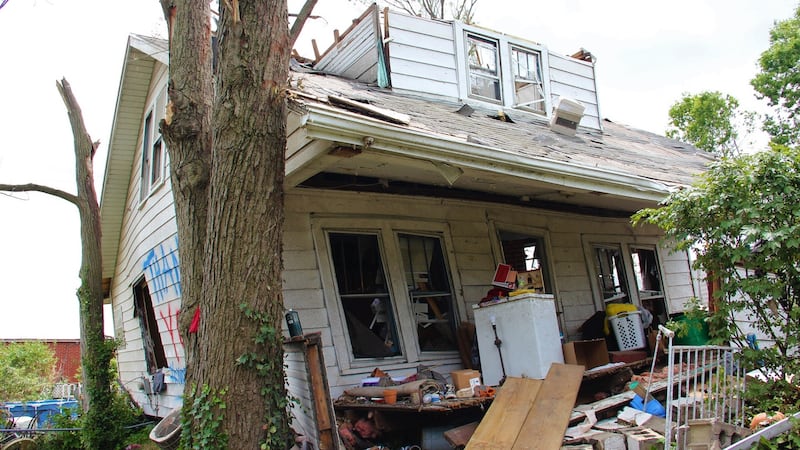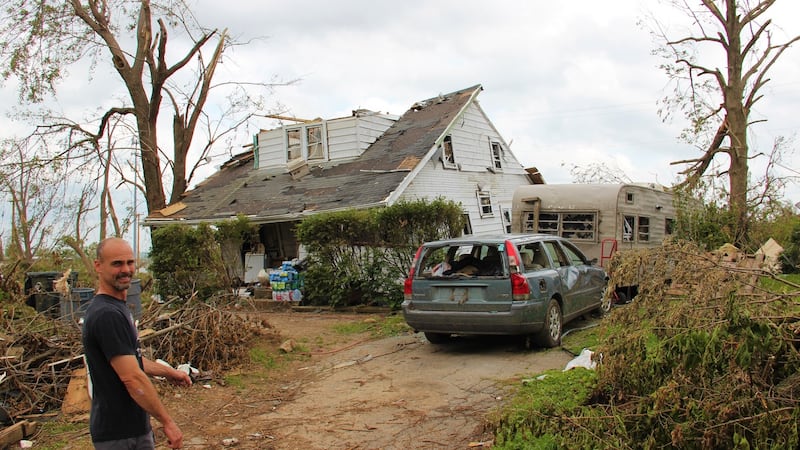The large family home at 2036 Maplegrove avenue, a quiet tree-line residential street north of downtown Dayton, Ohio is a wreck.
At around 11pm on May 27th last, an EF-4 tornado packing winds of 270km/h tore through the neighbourhood, destroying homes and lifting the house clear off its foundations, dropping it about 10m to the left, where two trees blocked it from being carried away entirely. "There was a mother and two kids in there, in the basement," says a neighbour. "When the tornado hit, she said her kids were lifted into the air and floated for a few seconds."

All around are scenes of devastation. Huge trees now resemble giant toothpicks. In numerous pockets of the area, homes and businesses have been wiped out, with insured property damage costs for the city estimated at $550 million (€488 million). Hundreds of homes have been destroyed beyond repair. Remarkably, just one fatality, 100km north in the town of Celina, has been attributed to the tornado outbreak.
Tornadoes, in general and of such severity, are not common in this part of the US. The so-called "Tornado Alley" that covers a huge swathe of the Midwestern Plains from northern Texas to South Dakota, where many of the 1,000-or-so annual twisters that touch down in the US occur, is more than 900km to the west.
Nationwide, May was the fourth-worst month for tornado activity since records began. For 14 straight days, at least eight tornadoes were recorded across the US for a historic total of at least 225 twisters. Since 1950, the years with the greatest number of tornadoes have all been since 1998. The deadliest was 2011 when 553 people were killed.
But not only are the number of days with multiple tornadoes on the rise, their location is changing, too. In recent decades, tornadoes have crept further east to regions where they were once uncommon. States such as Ohio and Indiana, and Alabama and Georgia in the south, where 32 people were killed last March – the deadliest for six years – have experienced the kind of tornado activity once reserved for Kansas, Oklahoma and states further west.
As a result, scientists and researchers are beginning to look at the possibility that thunderstorms with conditions favourable for tornado events and warmer, unstable weather attributed to climate change may be linked.
For now, efforts to explore that link are in their infancy, and experts say drawing parallels between the two is extremely difficult. "What climate change will do to tornadoes is complicated because tornadoes are very small and short-lived, whereas climate is exactly the opposite. So, the models that simulate climate have a very hard time resolving something as small as a tornado," says Michael Tippett, who researches the predictability and variability of climate patterns at Columbia University in New York.

Tornadoes are dependent on the strength of thunderstorms and wind shear – winds blown in different directions – and are often immediately preceded by heavy rain, near-continuous lightning and large hail. Warm, moist air at or near ground level and cool, dry air higher up in the atmosphere contribute to the unstable conditions that favour tornado formation.
In the US, they occur most commonly in late afternoon during the months of May and June, but exact times and locations are almost impossible to predict. In Ireland, they have been known to happen at any time of the year.
“What these kinds of projections suggest is that . . . overall, the frequency of favourable environments, in these locations, will increase,” says Tippett. “It doesn’t mean that you’ll be having tornadoes in places that would never have had them. But places which already have these kinds of storms, we expect in the future to have them more frequently.” Tippett also cautions that it’s difficult to forecast where storms that can lead to tornadoes will occur.
Nonetheless, with areas of the American midwest and south increasingly affected by tornadoes, changing weather patterns may also see European countries – Ireland included – at further risk from these damaging weather events. Experts have recorded as many as 30 tornadoes in Ireland in one year, though around 10 is closer to the mean. The majority are non-super cellular rather than super cellular, meaning that they form from vertically spinning air already near the ground and are generally weaker. “Gustnadoes”, land spouts and waterspouts are all examples of non-supercell tornadoes that have been regularly spotted in Ireland. Eighty-four tornadoes were reported to have occurred in Ireland between 2002 and 2013.
While a flat topography is more favourable to tornado formation, they've been recorded on Achill Island and in Limerick city through the centuries. "In Ireland, there have been tornadoes on relatively high mountain slopes as well as across the low lying-plains and loughs. There are no environments which are free from the possibility of such an event," says Dr John Tyrrell, formerly of UCC Department of Geography who is an expert on tornadoes in Ireland and author of a forthcoming book on the topic.
Fatalities
Tornadoes have long been a threat in Europe, with 316 fatalities and 4,462 injuries attributed to them between 1950 and 2015. Between 1910 and 1916, 81 people were recorded as having been killed by tornadoes in Austria, Germany and Italy. In November 1981, 104 tornadoes touched down in Wales and England in a single day.
Researchers at the University of Manchester and the European Severe Storms Laboratory in Wessling, Germany report that: "Between 1800 and 2014, 9,563 tornadoes were reported in Europe with an increase from eight tornadoes per year between 1800 and 1850 to 242 tornadoes per year between 2000 and 2014." The huge increase is mainly attributed to better observance of tornado events rather than a steep uptick in activity.
However, experts say that for the past 60 years, the threat in Europe has been erroneously disregarded by governments and citizens alike. A video of a bus being driven into the path of a tornado in southern Romania on April 30th last went viral, with the driver's actions resulting in several injuries. "Tornadoes are perceived as a curiosity in Europe and not as a threat and this can result, when a tornado occurs, not only in damages but also in more injuries and fatalities," says Bogdan Antonescu of the National Institute of Research and Development for Optoelectronics in Romania, who's written extensively on European tornado events.
For Tyrrell, because the concept of climate change, as it’s commonly understood, is erroneous since climate is “changing all the time”, tying tornado events to changing climate patterns is, in the first place, unhelpful. “Without knowing what is occurring now, analyses of the influence of climate change on tornadoes are premature,” he says.
At the same time, he believes there may be years when the number and severity of tornadoes landing in Ireland may increase. “Likewise, we can expect there to be years when the number will be lower than in most years as well as less intense than most years,” Tyrrell adds. “Be certain – there will be a more severe tornado than we have on record, and it may well be the next one.”







